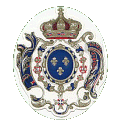Les Habitants du
Petit Fort
Bienvenue!
A Reenactment Company

 Portraying Life in Northwest Indiana
Portraying Life in Northwest Indiana
Circa 1755
A Member of La Brigade de Levis
|
Les Habitants du
Petit Fort |
|
|
Habitants
and Milice, Their Dress
One the Right is an artist depiction of what French militia would have looked like in 1750, and on the left is a picture of Reenactors today portraying the same people as they would have been. Typical Dress of a Habitant
Men:
“The
free life led by the Indians pleased them better than that of their European
relations; they dressed like the Indians and regulated all their affairs in
their way. It is therefore difficult to distinguish them, except by their
color, which is somewhat whiter than that of the Indians. There are likewise
examples of some Frenchmen going amongst the Indians and following their mode of
life.”
Chemise: A knee length cotton or linen shirt, considered to be an undergarment. Culottes or Breech cloth: A pair of knee length pants, usually wool or linen, which button around the knees, or a cloth worn over the loins. Hose: A pair of
cotton or wool socks , knee high Moccasins or Sole de Bouef: Leather slippers made in the native style with a center seam, or loafer style shoes made of ox hide. Belt or Waist Sash: Leather belt or cloth tie worn about the waist to provide back support Guillette: Small short vest, worn over the Chemise. Usually with out sleeves. (See the picture of unit member Jean Phillippe on the unit members page for a good example). Veste: Sleeved vest worn over the Gillette Capote or Justacorp: Heavy coat with large cuffs worn over all else, kind of like a suit coat. A Habitant would also carry a haversack or purse, which was a bag or pouch with personal belongings. Milice on campaign would also carry a cartridge box, for ammunition, a large knapsack for extra supplies and a musket. Women:
“All the women in the country without exception,
wear caps of some kind or other. Their jackets are short and so are their
skirts, which scarcely reach down to the middle of their legs. Their shoes are
often like those of the Finnish women, but are sometimes provided with heels.
They have a silver cross hanging down the breast. In general, they are very
industrious . . . In the country it is usual that when the husband receives a
visit from persons of rank and dines with them, his wife stands behind and
serves him, but in the town the ladies are more distinguished and would
willingly assume an equal if not superior position to their husbands. When they
go out of doors they wear long cloaks, which cover all their
Jupon: A garment very similiar to a skirt, only shorter. Many of these could be worn at once to show wealth and status. Chemise: An underskirt or shift worn under all of the outer petticoats and the jupon. Mantelet: A short women's waistcoat, worn with the jupon and chemise. Fichu: A square or oblong piece of cloth used by women as a modesty scarf worn about the neck and shoulders.
The traders of New France “appear to have been a
unique blend of French and
Indian, wearing Indian dress, traveling like Indians,
eating the same sort of food, speaking their languages, making war in the Indian
manner, living off the land and enduring privation with the fortitude of the
Indian”. In addition to the above articles of clothing the typical Habitant, man or woman, living on the frontier would wear "Native Style" dress as well. This could be just a pair of moccasins or beaded bag. Or the Habitant might be indistinguishable from a Native person except for skin color. It was not so much that the Habitants dressed like Natives, but that they both dressed like each other. Each culture borrowing clothing ideas from the other until a composite wardrobe was reached.
|
|
Page Last Updated on
Questions or Comments???
|